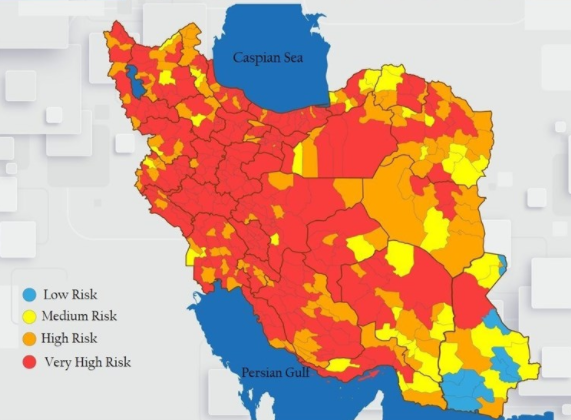May 14, 2021

Iran was hit by one of the world’s worst surges of the coronavirus in April, which appeared to be abating in mid-May but the government imposed a total ban on travel for the Eid al-Fitr holiday (May 11-15) out of fear of yet another surge in the disease.
The April surge was seen as resulting because the public generally ignored safety measures over the Now Ruz holidays, allowing the virus to spread to all corners of the country.
The daily count of new cases, which had never reached 9,000 before Now Ruz finally surpassed that number on March 29, then passed 10,000 on March 30, 11,000 on April 1 and 13,000 on April 5. It then took off, ballooning to a high of 25,882 on April 14, before declining slowly and falling below 20,000 on April 23.
The country has been among the top ten in the world for daily new cases ever since April 4.
The daily case number was down dramatically to XX,XXX on May XX but that “low” number was still higher than any daily figure before Now Ruz, showing that Iran was still being ravaged by the disease.
The daily death toll did not take off until after the daily volume of new cases began to ease. Since mid-April, Iran has generally been among the 10 countries with the most daily deaths. In fact, Iran has even had more daily deaths than the United States on XXXX days since mid-April.
The one positive statistic for Iran is that its scale of coronavirus deaths since the start of the epidemic more than a year ago ranks Iran only 54th in the world in terms of deaths per million population. However, that puts Iran third in Asia, the continent least impacted by the disease. In deaths per million in Asia, Lebanon ranks first, followed by Jordan, Iran and Israel.
To battle the epidemic, the government imposed its harshest closure rules on April 7. In Tehran, that meant that every business except a handful rated as essential was required to shut down. The exceptions were mainly food stores and pharmacies, plus some others such as dry cleaners and print shops. The same closure rules applied in all other cities rated red and orange.
President Rohani said April 24 that such tough measures were needed because only 60 percent of the population was adhering to the health rules when Iran needed to reach 90 percent compliance to turn back the disease.
There has been considerable resistance to the health rules coming from provincial political figures and many clerics. The national government banned congregational Friday prayers in all cities rated red. But the clergy in Mashhad, one of the worst impacted cities, balked and defiantly held congregational prayers.
President Rohani has blamed the British-originated mutation of the virus for the scale of the latest surge in Iran. “Despite all attempts made, we are unfortunately facing a fourth peak in the disease in the country, and the key contributor to this situation has been the British strain of Covid-19 getting into Iran from Iraq through borders of Khuzestan and Ilam provinces,” Rohani said in mid-April.
The lack of adherence to the ban against travel is best shown by the daily consumption of gasoline, which was down to 42 million liters a day last year during the two-week Now Ruz holiday but up to 90 million liters a day this year.
The government imposed its most stringent closure rules April 7 for two weeks and has extended the closures every week since then. But that was after the Now Ruz holiday had ended.
Movie theaters were among the businesses required to close April 7. But the movie theaters had only re-opened one week earlier.
The regime also canceled all public events scheduled annually for Qods Day, the last Friday in Ramadan, May 7 this year. This is a major political decision as Qods Day is the regime’s chief anti-Israel event of the year.
Deputy Health Minister Iraj Harirchi complained bitterly that members of the government’s coronavirus task force had blocked the Health Ministry request to start the lockdown before Now Ruz. The result, he said, was that the lockdown went into effect only after 85 percent of the country’s population was living in areas rated red or orange.
When the lockdown was ordered April 7, some 257 cities were rated red, 129 orange, 51 yellow and 11 blue.
As of May 10, a total of 46 cities were rated red, 263 as orange, 139 as yellow, while none were rated blue, which was reserved for cities that had the disease under control. In other words, the worst and best categories have shrunk while the two middle categories have swelled.